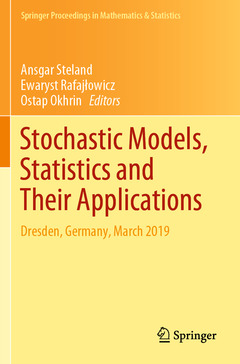Description
Stochastic Models, Statistics and Their Applications, 1st ed. 2019
Dresden, Germany, March 2019
Springer Proceedings in Mathematics & Statistics Series, Vol. 294
Language: English
Subjects for Stochastic Models, Statistics and Their Applications:
Publication date: 10-2020
450 p. · 15.5x23.5 cm · Paperback
Publication date: 10-2019
Support: Print on demand
Description
/li>Contents
/li>Biography
/li>Comment
/li>
This volume presents selected and peer-reviewed contributions from the 14th Workshop on Stochastic Models, Statistics and Their Applications, held in Dresden, Germany, on March 6-8, 2019. Addressing the needs of theoretical and applied researchers alike, the contributions provide an overview of the latest advances and trends in the areas of mathematical statistics and applied probability, and their applications to high-dimensional statistics, econometrics and time series analysis, statistics for stochastic processes, statistical machine learning, big data and data science, random matrix theory, quality control, change-point analysis and detection, finance, copulas, survival analysis and reliability, sequential experiments, empirical processes, and microsimulations. As the book demonstrates, stochastic models and related statistical procedures and algorithms are essential to more comprehensively understanding and solving present-day problems arising in e.g.the natural sciences, machine learning, data science, engineering, image analysis, genetics, econometrics and finance.
PART 1: Plenary Lectures: W. Stute, Stairway to hell.- I. Gijbels, R. Karim, A. Verhasselt, Quantile estimation in a generalized asymmetric distributional setting.- M. Ljungdahl, M. Podolskij, A note on parametric estimation of Levy moving average processes.- PART 2: Theory and Related Topics: K. Knight, A continuous-time iteratively reweighted least squares algorithm for $L_\infty$ estimation.- M. Bibinger, M. Trabs, On central limit theorems for power variations of the solution to the stochastic heat equation.- P. Gapeev, Perpetual dual American barrier options for short sellers.- P. Lachout, A criterion for weak convergence in vector Skorokhod spaces.- E. Liebscher, On combining star-shaped distributions and copulas.- E. Skubalska-Rafajlowicz, Stability of the Random-Projection Based Classifiers. The Bayes error perspective.- A. Ishii, K. Yata, M. Aoshima, A quadratic classifier for high-dimension, low-sample-size data under the strongly spiked eigenvalue model.- Z. Hlávka, M. Huskova, Doubly paired change-point analysis.- B. Darkhovsky, A. Piryatinska, Detection of changes in binary sequences.- Q. Liu, R. Zhang, Y. Xie, Distributed Change Detection via Average Consensus over Networks.- A. Steland, E. Rafajłowicz, The Hotelling-like T^2 control chart modified for detecting changes in images having the matrix normal distribution.- S. Vogel, Universal Confidence Sets for Solutions of Stochastic Optimization Problems - A Contribution to Quantification of Uncertainty.- Y. Liu, J. Wishart.- Local polynomial $M$-estimation in random design regression with dependent errors.- Ł. Smaga, Projection-based repeated measures analysis for functional data.- C. Weiß, On the Sample Coefficient of Nominal Variation.- B. Aleksandrov, A Negative-Binomial Index Considering Dispersion and Zero Probability.- PART 3: Stochastic Models, Methods and Simulations: J. P. Burgard, J. Krause, H. Merkle, R. Münnich, S. Schmaus, Conducting a Dynamic Microsimulation for Care Research: Data Generation, Transition Probabilities and Sensitivity Analysis.- M. E. Silva, I. Silva, C. Torres, Modelling overdispersion with integer-valued moving average processes.- E. Gonçalves, N. Mendes-Lopes, Zero-distorted Compound Poisson INGARCH models.- T. A. Möller, An Application of the Max-INAR(1) Model to Counts of Cinema Visitors.- J. Bracher, A new INARMA(1, 1) model with Poisson marginal.- S. Büscher, M. Batram, D. Bauer, Using motifs for population synthesis in multi-agent mobility simulation models.- U. Falkenhagen, W. Kössler, Hans-J. Lenz, A likelihood ratio test for inlier detection.- PART 4: Applications and Algorithms: A. Tordeux, M. Chraibi, A. Seyfried, A. Schadschneider, Artificial neural networks predicting pedestrian dynamics in complex buildings.- A. Gramacki, M. Kowal, M. Mazurkiewicz, J. Gramacki, A. Plawiak-Mowna, Automatic breast cancer diagnostics based on statistical analysis of shape and texture features of individual cell nuclei.- P. Sliwinski, P. Wachel,A. Galeziowski, Stochastic framework for contrast-detection autofocusing.- S. Krömer, W. Stummer, A new toolkit for mortality data analytics.- T. Górecki, P. Piasecki, A comprehensive comparison of distance measures for time series classification.- A. Homburg, Criteria to Validate Count Data Model Selection.- M. Romaniuk, On Some Applications of Simulations in Estimation of Maintenance Costs and in Statistical Tests for Fuzzy Settings.
Ansgar Steland received his Ph.D. in Mathematics from the University of Göttingen, Germany. After positions at the Technische Universität Berlin as a consultant, at the European University Viadrina and the Ruhr-University of Bochum, he joined the faculty of RWTH Aachen University, Germany, where he was appointed Full Professor at the Institute of Statistics in 2006. He is an Elected Member of the International Statistical Institute (ISI); Chair of the Society for Reliability, Quality and Safety; and Chair of the German Statistical Society’s Statistics in Natural Sciences and Technology Section. His main research interests are in change detection and quality control, high-dimensional statistics, time series analysis, nonparametric statistics, and image analysis and its applications to econometrics, the natural sciences and engineering, especially photovoltaics.
Ewaryst Rafajłowicz received his Ph.D. and D.Sc. degrees in Control Theory from WrocławUniversity of Technology, Poland. In 1996 he became a Full Professor, and in 2016 he was elected to the Polish Academy of Sciences as a Corresponding Member. He has been a Visiting Professor at many universities in the USA, Canada, Germany and England and has published ca. 150 papers on the identification of distributed-parameter systems, optimal design of experiments, signal processing, neural networks, nonparametric regression estimation, statistical quality control and image processing. In addition, he has served on the program committees of several international conferences and as a reviewer for many journals.
Ostap Okhrin is a Professor of Econometrics and Statistics at the Technische Universität Dresden, Germany. He worked at the European University Viadrina and later was an Assistant and then Associate Professor for Statistics of Financial Markets at the Humboldt-Universität zu Berlin and one of the principal investigators of the CRC-649 (Collaborative Research Cen




